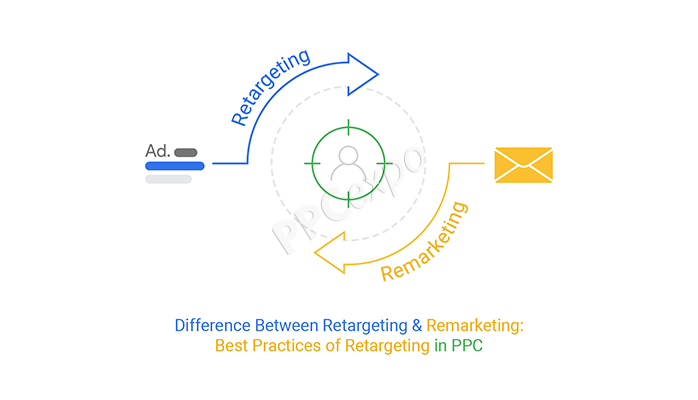Research shows that 97% of people who visit your website leave before making a purchase. What a huge loss! But you can turn the tables with retargeting and remarketing.

Marketers spend time researching audiences, planning, and analyzing factors. For most audiences that won't convert, it's a long and tedious process. Is it even worth it? Marketers are gradually understanding the essential role retargeting plays in increasing sales and customer loyalty. Your job is to make customers familiar with your brand until you're no longer just a random brand on the internet.
In this article, we'll delve into the differences between remarketing and retargeting. We'll also explore the best retargeting practices to give your PPC campaigns the best chance of success.
Differences between Retargeting and Remarketing
They sound similar, don't they? You're not alone! Some people may use them interchangeably. So are they similar? Over the years, the lines between retargeting and remarketing have blurred as these terms are considered to represent the same concept. In the digital marketing field, overlapping meanings of terms are common. However, there's some sense in their similarities. They both aim to increase the conversion rate of people interested in your brand. The difference between retargeting and remarketing lies in the strategy or execution. Retargeting is centered around paid ads, while remarketing uses channels like email campaigns to re-engage with people who have interacted with your brand in the past. Retargeting is done using cookies to follow users when they leave your website to other sites. In most cases, retargeting is described as focusing on online display ads for users who visited your site but left before purchasing. Don't assume people left just because they weren't convinced; some people simply need time to decide or get the money to make a purchase. The Google Display Network is one of the third-party channels that help you attract potential customers across multiple websites. The Google Display Network has over 2 million websites and blogs. There are 70,000 searches on Google every second. As a marketer, your job is to leverage this massive pool of activity.
I'm sure you've seen popup ads when using certain applications. These are part of Google Ads. Retargeting PPC ads also appear on Facebook, YouTube, and mobile websites. So, what different strategies do they use? As mentioned earlier, remarketing uses cookies to target display ads to potential customers, while retargeting uses email to send sales information. Both methods are effective. If you want the best digital marketing results, combine the two. The difference between retargeting and remarketing doesn't matter; it depends on how you leverage them.
Retargeting and remarketing put your brand in front of the target audience, then guide them back to your conversion channel. Target retargeting and remarketing achieve:
- Reaching target audiences who have already interacted with your brand.
- Attracting audiences in the final stages of conversion.
- Increasing brand awareness and visibility.
Benefits of Retargeting
Do you wonder if retargeting is worth it? I'm happy to inform you that retargeting never goes wrong. You are guaranteed results. Here are some benefits you can get from running retargeting ad campaigns:
Targeted Audience
There's a big difference between dialing random numbers and calling back the first person who called you from your call records. Retargeting helps your business reach out to interested potential customers rather than a broader target audience you think may be interested. So, rather than sharing your ads all over the internet, only people expressing interest will see those ads.
Expand Your Marketing Reach
With retargeting, you can reach a wider audience with your ads. Remember, your target audience is not just interacting with part of the internet. When creating PPC ad campaigns on Google, you can select keywords, demographics, and even locations to target. You can also choose to advertise on high-end websites at friendly prices.
Boost Brand Awareness
According to research, consumers need to see your brand seven times before they trust it. What does this mean for marketers? You need to reduce the time it takes for things to happen. That's why you should use retargeting. Retargeting reduces the time potential customers interact with your brand. Ads can appear multiple times on different network platforms that users visit. This acts as a booster to support your brand, building enough awareness in target customers to make a purchase decision. Sometimes people just aren't ready to buy yet. But with familiarity with your retargeting, the odds are in your favor, and you'll be on their minds when the time is right.
Better Engagement
Retargeting helps you reconnect with people meaningfully. Retargeting puts you ahead of 84% of the target traffic, making your brand competitive and increasing engagement metrics.
Insights for You
Numbers never lie. Another benefit of retargeting is that it can help you understand where the majority of your retargeted audience has been captured. Retargeting tracks the performance of your previous ad campaigns. Over time, you'll be able to view this data, analyze your progress, and maximize results.
Enhancing Brand Competitiveness
Competition in e-commerce is inevitable. But being last in line doesn't feel good. Using retargeting to establish a level playing field with those well-known brands makes your brand more competitive. When users search for products, they not only see industry giants but also have a chance to see you.
Generating More Sales
This is the most critical benefit of retargeting. We have indeed saved the best for last. While running a successful business involves many factors, revenue is the lifeblood to keep the company breathing. Conversions are what every marketer hopes for when running their preferred marketing strategies. If you want to convert the 97% we talked about at the beginning of the article, retargeting can do that. Keep an eye on those interested in your brand, build familiarity and trust, and they'll be back soon.
How Retargeting Works
When you open a website on a search page, cookies are saved by the web browser. As a marketer, cookie data is what you use to repeatedly show ads to users. Using the Google Display Network, you'll cover 90% of internet users across 2 million sites using display ads. By showing these PPC ads to people who have visited your site when they browse other websites, you can build brand awareness and increase conversion opportunities.
Advantages of Retargeting in PPC
- It can remind previous visitors. They may have clicked first, but the fact is they clicked first. You now have a second chance with that user.
- Google Analytics tracks the number of revisiting visitors. This provides valuable information for creating future retargeting ad campaigns.
- You have the opportunity to personalize retargeting ads. You can use humor, doodles, discounts, or strong calls-to-action (CTAs).
- Data collected from past ad campaigns is very helpful for improving your future ad campaigns and your website.
- Customers who see retargeting ads are 3 times more likely to click on the ad than customers who have never seen your brand.
- 59% of users are neutral about retargeting ads. This is an important statistic to note as 67% of users find online ads annoying.
- Retargeting can increase ad response rates by up to 400%, according to research.
Disadvantages of Retargeting in PPC
- Retargeting ads may come off as creepy or unsettling as they target users coming from visiting these sites.
- Nobody likes being tracked. For most people, seeing ads multiple times can be annoying.
- Retargeting campaigns may show to people who have already purchased the product.
- Ad fatigue is real, so you need to create new ads frequently; otherwise, you may not get any positive responses.
Best Retargeting Practices for Your Business
Retargeting campaigns ensure you bring back people who have already visited your website. This is the best way to ensure you're leveraging existing familiarity.
Retargeting is one of the most effective marketing strategies out there. it has the most significant impact on a business. Whether the goal is to build brand awareness, customer conversions, or both, retargeting is the bet you need to place in your marketing plans.
Retargeting seems like a simple thing throughout this article. Don't misunderstand me, there's some truth to it. However, it boils down to the quality of your ad campaigns. A poorly executed campaign will thwart your marketing efforts and not yield the results you desire. Here's a list of best practices you can use to make the most of retargeting:
Don't Overbear or Under-serve
Marketing is strategic. You don't want to be known as the brand that does too much. It annoys potential and past customers. You also don't want to do the bare minimum. It means you'll miss out on incredible opportunities available in retargeting. The solution is to find a middle ground between being overbearing and underwhelming.
What does this balance look like? 15 to 20 impressions per user per month is a pretty good frequency, depending on your minimum budget and targets.
Brand Your Ads
The Google Display Network guarantees your ads are shown to your target audience. But you play an important role. Your ads need to spark interest and establish a connection with the audience. When you see an ad, what makes you know which brand it is? The logo. When creating ads, ensure your logo and other brand characteristics are prominent. Make sure there's no confusion or doubt in the audience's minds about the brand they're seeing.
Understand View-through Conversions
Billboards are effective advertising tools. They are large outdoor boards that display ads. Billboards themselves represent a complete advertising channel. Billboards contain all the information a user needs to interact with and make a decision about the brand. Banner ads are similar. Users are influenced without the need to click.
As a marketer, you need to understand how view-through conversions work to fully leverage them. Once a user views your retargeting ad, visits your website, and makes a purchase without reopening the ad, track those conversions. View-through conversions can be tracked within 24 hours or 30 days. It's best to track within 24 hours as that's when the retargeting billboard effect takes place.
Optimize Your Conversion Funnel
Testing your ad creatives and having good target landing pages are equally important as creating great ads for your brand. You can start interactions with two creative and see how your ads might perform. If the argument shows low potential, disable it and create new optimizing iterations. Keep testing until you reach your desired metrics.
Target Actionable Audiences
This method can effectively promote products to specific target audiences. Most people leave their tracking on log-in pages or homepages. This is done to target those with some knowledge about your brand. If this is your approach, you may not be retargeting the right audience.
Think about it. Your website has different pages, right? So, if you only look at people visiting the log-in page, you're missing out on the full picture. Keeping this in mind, place your tracking code on all pages of your website instead of entry points. This ensures actionable audiences stay and make decisions.
Why Are Remarketing Campaigns Important?
Retargeting is similar to building a friendship. You may have noticed that to build a friendship, regular communication is needed. This is why the term social capital exists. It's the relationship network of people living together.
Everyone can play a role in building social capital. Similarly, remarketing helps build relationships between your brand and its customers. Remarketing campaigns are crucial because:
- Retargeting is a part of a mature business's overall marketing strategy. So, what constitutes a mature business? If your website sees at least 100 visitors per month, you can use retargeting.
- Retargeting also helps you identify your number one fans—those loyal to your brand and keep coming back.
- It's also an excellent way to drive bestselling products. Promoting products your customers have already loved is one way to drive sales and increase return on investment.
- When you launch new products, remarketing is crucial. Customers love to see new products and upgrades to old ones. Remarketing catches the eye of those waiting to see new things. For this, you can use Facebook Ads or Google Ads.
- Clearing out stock—every healthy business goes through slow-moving stock occasionally. With remarketing, you can help sell these products by offering discounts or other sales incentives.
- Brand awareness is crucial as it helps make your target audience familiar with and trust your brand. People buy from brands they feel they already know.
Remarketing Options in Google Ads
Google Ads offers a variety of remarketing opportunities. They include:
- Standard Remarketing
This tool allows you to show your ads to users who have visited your site when browsing websites on the Google Display Network.
- Dynamic Remarketing
Have you ever seen ads for specific products you may have clicked on when using e-commerce sites like Amazon or Alibaba? That's the role of dynamic remarketing. It displays users, products, or services they viewed on your site.
- Mobile App Remarketing
If you have a mobile app, this feature is for you. If someone uses your app, Google Ads will show them your ads when they visit other mobile apps and mobile websites.
- Search Ads Remarketing Lists
This tool, also known as RLSA, allows you to show your ads to past visitors on search engine pages. You can personalize ads to be more appealing to that target group.
- Video Remarketing
If you have a YouTube channel or other videos, Google can help you show ads to people who have interacted with them. These ads pop up when users watch YouTube videos as well as interact with other video content on the Display Network.
- Email List Remarketing
Also known as Customer Match. If you have a customer email list, upload it to Google Ads. After doing this, if they're logged into YouTube, Gmail, and Google, you can reach them.
How to Set Up Google Ads Retargeting
The first step is tagging. This depends on your retargeting goals for your business and the types of campaigns you plan to run. Generally, it involves tagging on apps, YouTube, Facebook, Google Analytics, etc.
If your goal is to target users who previously visited your site, use basic Google Ads code.
If you're looking to start using Google Ads retargeting, here's a step-by-step guide.
Step 1:
Click on the tools icon in the Google Ads navigation bar.
Click on "Audience Manager" under "Shared Library."
Step 2:
Click on "Audience sources" in the left-hand menu.
Here, you can select the tags to set up for remarketing goals.
Step 3:
Click on "Set up tag" under "Google Ads tag."
When you click on setting up the Google Ads code, you can customize the data collected based on your fields. If you prefer only collecting standard data, select the first option.
Step 4:
Click "Save" to continue.
Step 5:
Choose how you'd like to install the tag.
If you have web developers in your company, you can send the tag to them via email for them to add to your site. Alternatively, have them use Google Tag Manager.
Another option is to do it yourself.
Copy and paste the Google Ads retargeting script onto every page of your website (between the <head></head> tags):
Wrap Up
Retargeting is a vital part of digital marketing. Have you encountered poor sales, low return on investment, or a lack of brand awareness? Retargeting can flip the script. It allows you to reach out to those who've visited your site but left before making a purchase. It's well known that online users buy from brands they trust. Retargeting is built on the foundation of brand awareness, which is the way customers gain familiarity and trust. To run successful retargeting ad campaigns, you need to create excellent campaigns using the best retargeting practices discussed above. To monitor the progress of your campaigns, you need tools like PPC Signal. It can help you track the performance of your campaigns to understand areas of excellence and areas where you can improve.
The img tags within the article should not be modified directly and should be retained as is! With well-structured H tags.


